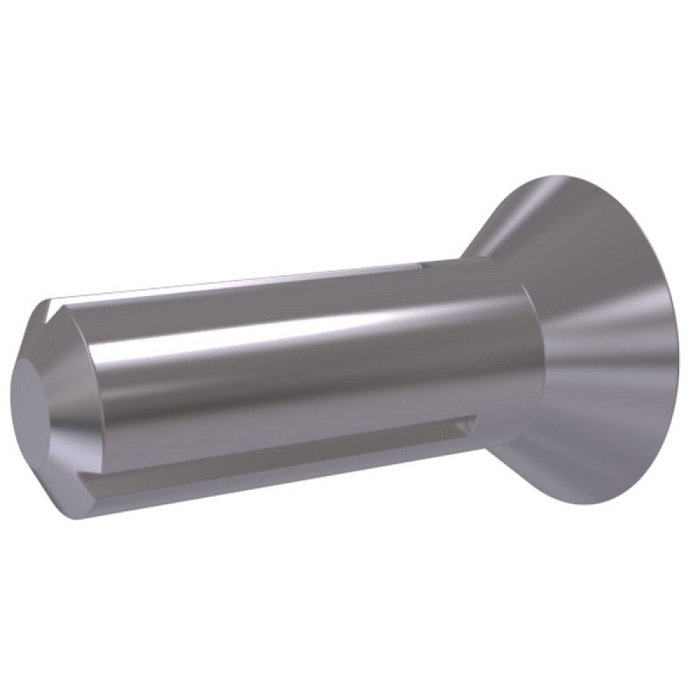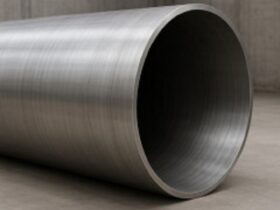Standardization in the industry is a key element to ensure a high level of quality and compatibility between products. The DIN 1477 (ISO 8747) pin with notches and countersunk head is an example of successful engineering solutions that ensure a reliable connection in various industries.
Content:
1. Introduction
2. History and development
3. Main characteristics
4. Application in various fields
5. Advantages and challenges
6. Innovations and the future of development
7. Conclusion
1. Introduction
In today’s industrial and engineering industry, where precision and reliability of connections are crucial, the application of standards for products and components becomes an important element. Among the wide range of connection elements, the pin DIN 1477 (ISO 8747) stands out , which plays a key role in the stability and efficiency of structures.
The DIN 1477 (ISO 8747) countersunk pin is the result of systematic development and standardization to meet the high demands of the industry. In this article, we will look at various aspects of this standard, revealing its history, main characteristics, areas of application, as well as highlighting the advantages and challenges associated with the use of this type of pin. A detailed analysis and discussion of innovations and prospects for the development of the standard will allow us to better understand its place in the industry and identify opportunities for further improvement of technical processes.
2. History and development
The DIN 1477 (ISO 8747) standard appeared on the world stage due to market requirements and manufacturers’ needs for reliable connections. Its history is marked by a constant drive to improve and adapt to growing technological challenges.
The beginning of the journey: The initial stage of development of the DIN 1477 (ISO 8747) pin dates back to the middle of the 20th century, when engineers and manufacturers began to realize the need to standardize products to ensure compatibility and ease of installation. The first attempts at standardization included basic characteristics, but did not always take into account the requirements for connections in difficult operating conditions.
Evolution of the standard: Over the years, the DIN 1477 (ISO 8747) pin has evolved, taking into account technological progress and high quality standards. Working groups and expert committees actively collaborated to determine optimal dimensions, materials and designs to ensure maximum pin reliability and durability.
International standardization: Over time, the DIN 1477 standard became the object of international attention, and its parameters and characteristics were included in the international standard ISO 8747. This was a step towards global recognition and a unified quality system in the field of pin production.
Modern challenges and responses: In today’s environment, the DIN 1477 (ISO 8747) pin continues to adapt to the challenges of production and technical innovation. Interoperability with other standards and the introduction of new materials are key aspects of the further development of this connection element.
The history and development of the DIN 1477 (ISO 8747) pin show how the systematic work of engineers and standardization organizations is aimed at the improvement and reliability of structural elements, which is important for the development of modern industry.
3. Main characteristics
The DIN 1477 (ISO 8747) pin stands out for its detailed design and numerous features that make it an indispensable element for many manufacturing industries. Let’s look at the main parameters of this pin:
- Length: Pins are available in a variety of lengths, allowing them to be used in a variety of designs and applications. The standard defines specific dimensions that simplify the selection of the required length depending on the requirements of a specific project.
- Diameter: The diameter of a pin is a critical parameter that determines its strength and durability. Manufacturers produce pins with different diameters to meet different needs for strength and structural properties.
- Material: Pins can be made from a variety of materials, such as carbon or stainless steel, aluminum, or other alloys. The choice of material depends on operating conditions, requirements for strength and corrosion resistance.
- Head: The countersunk head is a key design element. It allows the pin to enter the hole and be securely fixed in the connection. High-quality processing of the head ensures reliable fixation and protection against unwanted influences.
- Notches: The notches on the surface of the pin serve to improve its retention in the material in which it is fixed. This is especially important for strong and stable connections during operation.
- Coating: Some pin modifications may have a special coating to protect against corrosion or improve friction properties. This can be especially important in humid or aggressive environments.
Engineering attention to these characteristics ensures that the DIN 1477 (ISO 8747) pin can be used effectively in a variety of conditions and industries, providing a reliable and stable connection.
4. Application in various fields
Pin DIN 1477 (ISO 8747) is a universal connection element that is widely used in various industries due to its properties and reliability. Let’s consider the main areas of its application:
- Automotive industry: In the automotive industry, DIN 1477 pins are used to connect various components such as brake systems, suspension, body parts and other components. Their high strength and ability to carry large loads make them an important component in automotive production.
- Mechanical engineering: In the field of mechanical engineering, DIN 1477 pins are used to connect parts of mechanisms, tools and machines. They guarantee stability and reliability of structures, which is important for optimal functionality of machines and equipment.
- Construction: In the construction industry, DIN 1477 pins are used to connect structural elements, fittings and other components. Their strength and durability make them ideal for use in environments where structural reliability is important.
- Electrical engineering: In electronics and electrical engineering manufacturing, where precision and stability are important, DIN 1477 pins are used to connect printed circuit boards, enclosures and other electronic components.
- Instrumentation: In the instrument industry, DIN 1477 pins can be used to connect a variety of instruments, sensors and measuring devices, ensuring stability and reliability of the devices.
- Aerospace industry: In heavy aerospace and aeronautical engineering, DIN 1477 pins can be used in elements where high strength and reliability of connections with minimum weight are required.
- Metalworking: In the field of metalworking, pins of this standard can be used to fasten and fix parts during processing, ensuring accuracy and stability of the process.
A common feature is that the pin DIN 1477 (ISO 8747) is used where the reliability and stability of the connections are important, and where its parameters can effectively interact with the specifics of the specific industry.
5. Advantages and challenges
Pin DIN 1477 (ISO 8747) is characterized by a number of advantages that ensure its wide application in various industries. However, along with the task of solving specific tasks come challenges that require attention and development.
Advantages:
- Reliability: The DIN 1477 pin is characterized by high reliability in connections, which makes it a popular element for use in situations where stability and durability are important.
- Versatility: The specifications of the standard allow manufacturers to create pins of different lengths, diameters and materials, making them versatile for a variety of applications.
- Ease of installation: The countersunk head makes it easy to install the pin and provides a secure connection without protruding elements.
- High resistance to loads: Pins of this standard are able to withstand significant mechanical loads, making them effective for difficult operating conditions.
- Corrosion protection: The use of stainless steels or other corrosion-resistant materials allows the pins to withstand aggressive environments and ensures their long service life.
Challenges:
- Assembly and Disassembly: In some cases, assembly and disassembly can be a challenge, especially in cases where access to the pin is limited.
- Manufacturing precision: To achieve optimal performance, it is important to produce pins with high precision and quality, which can be a challenge for manufacturers.
- Material requirements: Some manufacturing industries, such as the aerospace industry, may have high material requirements, which can affect the cost and availability of pins.
- Quality control: Ensuring high production quality and compliance with standards requires systematic quality control, which can be a challenge for some manufacturers.
All these challenges are solved by a system approach to the design, production and operation of the DIN 1477 (ISO 8747) pin, and its advantages allow it to be used effectively in various fields.
6. Innovations and the future of development
The DIN 1477 (ISO 8747) pin, carrying a successful heritage and recognition in various industries, continues to improve and adapt to the challenges of today through innovation and technological progress.
1. Improvement of materials: The first priority is to improve the materials used in the production of pins. Research into new steels, titanium alloys and composite materials can lead to the development of lighter, stronger and more durable pins.
2. More accurate manufacturing technologies: The introduction of advanced manufacturing technologies allows to achieve a higher level of accuracy and product quality. This may include the use of laser or water jet machining to create precise notches and heads.
3. Integration of sensor and communication technologies: Thanks to the development of the Internet of Things (IoT), it is possible to embed sensors and communication chips in pins to track their condition, pressure and temperature in real time.
4. Geometry and Design Optimization: Analysis of pin geometry and design can lead to optimization of its performance to improve strength, stability and reduce weight.
5. Environmental compatibility: The growing attention to ecological production standards is stimulating the development of biodegradable materials and manufacturing processes, which will reduce the impact on the environment.
6. Collaboration with other technologies: Integrating pins with other technologies, such as 3D printing or robotics, can open new possibilities for production and applications in various industries.
7. Personalized and custom solutions: The increased interest in personalization of products can lead to the development of custom solutions for specific industries and tasks.
8. Expansion of the scope of application: Development of new concepts and expansion of the scope of application of the pin in other industries and types of production, where its potential has not yet been fully revealed.
All these innovations and technological improvements are aimed at providing the DIN 1477 (ISO 8747) pin with even greater efficiency and adaptability to changes in production and market requirements. The consistent development of this standard reflects the importance of its role in today’s industry.
7. Conclusion
At the end of our study of the DIN 1477 (ISO 8747) slotted countersunk pin standard, it is important to note its significance and prospects in today’s industry. This standard defines norms for an element that may seem small, but plays a key role in reliable and stable connections in various industries.
Pin DIN 1477 (ISO 8747) stands out for its versatility, reliability and ability to adapt to various challenges of technological development. Its use is widespread in the automotive industry, construction, electrical engineering and other industries due to properties that ensure reliability and stability in various operating conditions.
The future development of the DIN 1477 (ISO 8747) pin is seen in the integration of advanced technologies, the improvement of materials, as well as the expansion of the scope of application. Reflecting the needs of modern manufacturing and growing technological requirements, this standard will have the opportunity to become even more modern and adaptable to the rapidly changing industrial environment.
All things considered, the DIN 1477 (ISO 8747) pin acts not only as a structural element, but also as an important link in the standardization system that contributes to safety and production efficiency. With its help, the industry develops, improves the quality of products and simplifies the processes of interaction between different industries.









Leave a Reply
View Comments